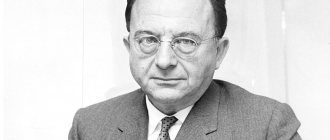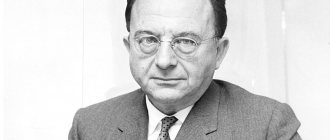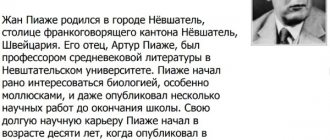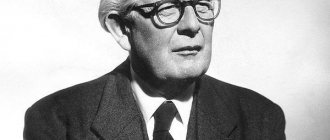Genetic psychology is a branch of psychological science founded by Jean Piaget. He viewed the formation of personality and its cognitive component as a continuous process of development. According to Piaget, a child's intelligence is formed on the basis of innate characteristics and is supplemented by those that arise during interaction with the outside world.
Genetic psychology - what is it?
The term “genetic psychology” does not quite accurately reflect the main interest of scientists who work in this field. The modern concept of “genetic” is more related to the human genome in the biological sense.
Piaget, in the field that he developed, considered genetics as one of the aspects of individual development. Therefore, science is engaged in the study of processes occurring within the framework of ontogenesis - the formation of intelligence, its origin, mechanisms of complication.
For Piaget, the priority was to study the process of developing knowledge and improving its quality. The scientist was interested in where knowledge comes from and how it is perceived, how it influences the world around us and a person’s personality. I studied how much knowledge is objective or subjective. Piaget's focus was on issues of epistemology.
The term “epistemology” denotes a discipline that examines scientific knowledge in detail - its structure, functions, development. Piaget perceived himself as an epistemologist. He became the founder of the International Center for Genetic Epistemology (in Geneva) and headed it.
Genetic psychology has become the basis for the further development of epistemology, but it is not easy to understand where the border between these two disciplines lies.
In scientific sources published in English, the term genetic epistemology (or developmental theory of knowledge) means exactly the same thing as what we mean by genetic psychology. The same term in English-language sources is used when talking about science that studies the influence of genes on the formation of the psyche and personality, studying the connection between genetics and individual behavior (using the twin method or through adopted children).
Key Ideas
Jean Piaget's genetic psychology focuses on:
- personality development in childhood:
- peculiarities of the child’s logic;
- cognitive mechanisms;
- the influence of internal and external factors on them;
- the reasons and process of transition from one form of thinking to another;
- general and differences in the psyche of an adult and a child.
To identify them, within the framework of genetic psychology , Piaget used the method he created - a clinical conversation. It was the main tool for studying a child’s thinking and made it possible to study not external signs of development or its absence, but the processes that stimulate it.
Piaget put forward several ideas that were further developed in the works of other scientists. The main one is that in order to develop intelligence, the child’s psyche needs a dynamic balance, which is established as the structures of logic develop. They are not innate, but arise and improve gradually.
The central idea put forward by Piaget was the idea of transformation. It indicates that initially there is no clear permanent boundary separating the object and the subject. Knowledge is formed in the process of interaction of the subject with objects.
The idea of construction reflects Piaget's vision that knowledge is formed through certain structures of action. They arise gradually, but initially there are no structures either in objects or in the subject. Their absence should force the subject to master the ability to coordinate actions.
The main functions that help an individual interact with the outside world are organization and adaptation. They are unchangeable, determined by heredity, and do not depend in any way on experience and content. The structures of the psyche are determined by acquired experience; they are formed throughout life. This difference in functions and structures makes it possible for the psyche to undergo qualitative changes and smoothly move from one stage of development to the next.
Mental disorder
If we talk about genetics and the formation of thinking, the question immediately arises as to why absolutely healthy parents give birth to children with psychological disorders.
Here it should immediately be noted that when taking into account genetics in the formation of personality, they pay attention to the psychology of not only parents, but also grandparents up to the 3rd generation. Therefore, it is quite difficult to draw conclusions based only on the personalities of the parents. In addition, scientists still cannot unanimously say why certain failures occur; the child is not born healthy, especially if the woman took care of herself before and during pregnancy. There is an assumption that a major role is played by DNA cells, which for unknown reasons are not correctly positioned during the process of conception and development of the embryo. But this fact cannot be confirmed or refuted 100% in any case.
Genetic psychology is not only an interesting, but also a useful science, which explains to young parents that it is not enough just to conceive a child, they also need to raise him correctly. And then another brilliant and unique personality will appear in the world.
Intelligence and principles of its development
Intellectual development is a continuation of the biologically determined process of adaptation. This is one of the forms of adaptation to changing life circumstances.
Changes in the external environment occur constantly. A person strives to establish and maintain balance in these circumstances. At the cognitive and behavioral levels, adaptation occurs through action patterns, as well as accommodation and assimilation:
- action schemes are formed in the individual as concepts or a set of algorithms used when interacting with the external environment or in the process of dividing into categories. For example, babies have a pattern of sucking, grasping (they are innate), they know how to push;
- Assimilation is a process in which an individual uses an existing schema in relation to a previously unknown object. This makes it possible to establish successful interactions. Thus, small children grab an unfamiliar object (pencil) with the same habitual movement as their mother’s finger;
- During the process of accommodation, the scheme changes or a new one is created. At some point, the baby begins to understand that it is not possible to grab the ball with the same movement as the mother’s finger. It changes the movement (creates a different pattern).
The continuous process of interaction with the world, maintaining contact with it and balance using the mechanisms of cognition is the essence of the process of child development, the formation of his thinking. The need to establish a balance between one's own needs, aspirations and the reality of the world around us is the driving force behind the development of intelligence.
The genetic method does not consider intelligence as an innate formation, but in human nature there is a desire to develop and improve intelligence. Thanks to this feature, a person can think and expand his knowledge base.
Activity and the need to interact with objects and people around us contribute to the development of intelligence. In the process of interaction, the individual’s knowledge expands, a system of concepts and action patterns is formed, and logical structures are improved.
Psychological research methods provide an understanding that an individual’s actions with external objects are a source of knowledge. In the case when actions are aimed at external objects, the individual activates internal processes, as a result of which schemes, concepts, and awarenesses are formed. Otherwise, the basic concepts are not a given. They arise as a result of the fact that a person transforms the experience gained from interacting with the outside world into internal structures.
Summary
So, we have found out that genetic psychology deals with the development and origin of intelligence, the processes and characteristics of the acquisition of knowledge and the ability to think. Its founder, the Swiss scientist Jean Piaget, viewed intelligence as a specific way of adapting human beings to a constantly changing external environment. To successfully adapt to its conditions and maintain this balance, the individual develops his intellectual abilities, which allows him to be in balance with the world and successfully exist in it.
The improvement of intelligence itself represents a transition from less to more complex forms of understanding reality, from concrete sensory to logical thinking and the ability to operate with mental and intellectual categories and concepts. At the same time, knowledge and intelligence are not a given at all, but are the result of mental structures created by the individual. In this way, a person constructs his knowledge and forms his complex cognitive-intellectual apparatus.
It is never too late to develop intelligence and thinking, and this is no less important for adults than for children. For this purpose, we have created a practical program “Cognitive Science. Development of thinking”, which is designed to teach 20 thinking techniques. This online training helps you develop and hone the skill of thinking effectively, logically and consistently, as well as quickly making constructive decisions. We invite you to join it.
And finally, we wish everyone clear and effective thinking!
We also recommend reading:
- Storytelling
- Criminal psychology
- Skinner's operant conditioning as a technology for personality formation
- Theories of thinking
- Cognitive development. Part 1
- Cognitive schemas
- Cognitive psychology and cognitive psychotherapy
- Cognitive development. Part 2
- Piaget's theory of cognitive development
- Psycholinguistics as a tool for in-depth study of speech and language
- Speech thinking in children and adults: what is it and why is it needed?
Key words:1Cognitive science
Stages of intelligence development
Within the framework of genetic psychology, Jean Piaget considered several stages of the development of intelligence. By analogy with the name of each of these stages, the types of intelligence that develop in children as they grow up are also designated.
Features of the sensorimotor stage
Only a born child perceives himself as a single whole with his mother and the surrounding world. In the process of interacting with other people, with toys, he begins to understand that he is separate from them. He also comes to understand that his own actions can affect objects.
Touching a toy hanging above the crib, the baby sees it swinging. Waving a rattle, he hears a sound. This is how a small child gets acquainted with the world, and at the same time he develops action patterns and concepts. They are based on the mechanisms of accommodation and assimilation.
At the sensorimotor stage, the child learns the principle of constancy. It lies in the fact that an object exists even when it becomes inaccessible to the senses (disappears from sight or becomes inaudible).
The baby develops the ability to anticipate the place where an object that is moving but hidden from view should appear.
An important acquisition of the sensorimotor stage of development is the transition from reflex activity to behavior that is caused by curiosity and the desire to experiment.
The child actively explores the space around him, experiments with influencing external objects with different intensities. He needs this to expand the base of patterns, knowledge, and develop thinking.
At the final stage of the sensorimotor period, the child can cope with simple tasks, while he relies on the sensory information he already has. Gradually there is a transition from thinking of a concrete-sensual type to a symbolic one.
Features of the operational stage
This stage of development is characterized by the appearance of speech and imaginative thinking in the child. The baby can already pretend, imagine, use words behind which a certain meaning is hidden.
In the preoperative period, the ability to think logically, manipulate information and use it in the thinking process has not yet been formed. That is why this stage of development is called pre-conceptual.
Features of the operational stage
The child moves to the operational stage of development closer to the age of seven. The baby’s thinking is already developed enough to perform simple logical tasks. But it is still difficult for a child to use logic for mental actions - for this he needs physical interaction with an object. It is difficult for a child to understand an abstract situation or idea.
The operational stage lasts until the beginning of adolescence (12 years). Domestic psychologists who studied the development process combined the operational stage with the formal operational stage. But Jean Piaget considered another important period in the development of personality, its intellect.
Features of the stage of formal operations
During this period, the child develops the ability to think abstractly and actively use logic. The personality moves to the next, higher stage of development (according to Piaget, the highest).
The child is already able to think actively, comprehend information objectively, and uses his existing knowledge to create abstract ideas. An important acquisition of this stage is the ability to predict the result of a certain activity, set a goal (abstract) and act to achieve it.
Irina Sherbul
History of research development
The founder of the theory, Jean Piaget, began the main study of human intelligence with the study of the child’s mind. He based all his reasoning on logic and biology.
He conducted several experiments in which he tried to clearly show that the level of understanding and intelligence (intellectual development) have a huge impact on the child’s speech, his perception of the environment and himself and, of course, memory.
Jean Piaget. Child's speech and thinking
One of the first works of J. Piaget, which combined all his research in the field of the relationship between children's thinking and the development of speech function.
Several experiments have helped prove that children can judge the same phenomenon in different ways.
When they are not given additional data about the subject and are asked to sketch it, the nature of their drawings can be traced alone, but when they are then told about some details related to the subject of their study (for example, several communicating vessels with water, one of which is closed cork), then the nature of their drawings becomes different.
They begin to sketch an object based on their acquired knowledge (for example, more carefully show different levels of water in vessels), and apply this tactic to other phenomena or objects.
Gradually Piaget developed his theory. In the 20s of the 20th century, he based his research on the development of thinking on the connection between thinking and speech in children.
He literally collected the most common questions from the “whys” and then asked them himself. For example, “Where does the rain come from?”, “Why does the wind blow?”, “Where does the sun go at night? To visit the moon? etc.
Having received answers from children to such questions, Piaget came to the conclusion that a child’s thinking goes through several stages of development at once:
- Exteriorization . This is an autistic (internal) analysis that occurs in the child’s mind when the need arises to answer a difficult question.
- Egocentrism . This stage follows the first. This is the transformation of thinking from internal to realistic or external.
The psychologist saw the same connections in the development of speech. It, too, is first formed internally, being “speech for oneself,” and then transformed into social, i.e. into “speech for others.”
Piaget's position attracted the interest of many eminent psychologists around the world. L.S. also showed interest in the study. Vygotsky, and V. Stern and others. The discoveries made by Piaget during these years helped to outline in much more detail the mechanism of development of children's intelligence (and then apply this knowledge to study the intelligence of adults).
At the second stage of his research, which occurred in the 30s, Piaget studied the operational side of children's thinking. He developed special excrements to theorize his thoughts.
But at this time, in fact, Piaget remained the only researcher who considered the problem of the development of intelligence from this side.
Vygotsky, Stern, Bühler and his other colleagues were interested not so much in the process of intellectual development as in the products of mental activity (i.e. the result, not the development).










